INSIDE
RACING
T E C H N O L O G Y
IRT Home
IRT Home
News Page
Contents Page
Newsletter &
Books
email Paul
New Aero Doo-Dads
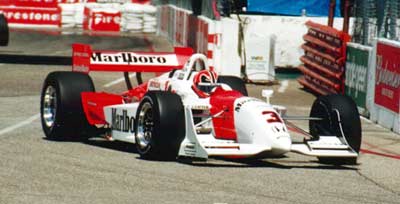
That's race-winner Helio Castroneves entering Turn 10 at Long Beach. He won the race at Long Beach and his Penske teammate, Gil de Ferran, finished third.
Although Lola and Reynard are the only official chassis builders Team Penske has altered the aerodynamic configuration of their Reynards such that it probably qualifies as a third design.
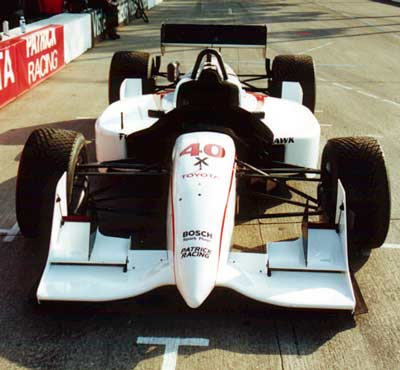
A front view of a Reynard chassis, Jimmy Vasser's car, gives a good look at the front wing. The center of the wing is raised and the vertical fins and end plates are large.
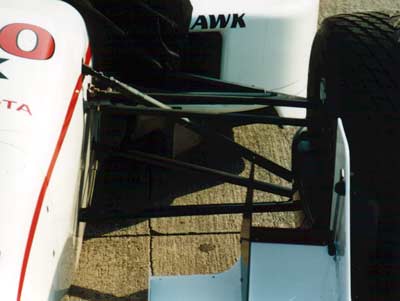
The inlet to the underwing is dominated by three vertical vanes curving off to the right. You can barely see them in the shadow.
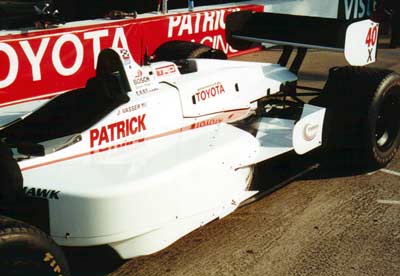
The side view of Jimmy's car shows the area in front of the rear tire that is important because there are no rules restricting bodywork in this area. You just can't have anything within 4 inches of the tire. So there is a flat plane there supporting a small kick up with an end plate on the outside. These things are called fugelhorns for no apparent reason. They produce some downforce and lower drag produced by the tire.
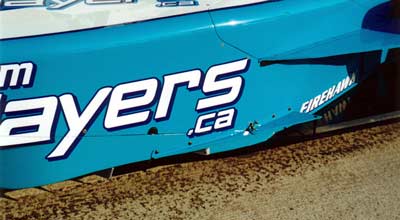
A closer view of one of the Player's Forsythe cars is provides a view of a small, triangular vortex generator just to the left of the FIREHAWK decal. Now that you know where it is you can see it on the photo of the 40 car. I would guess that device adds some swirl to the flow that helps the air stay attached to the body work as it tries to turn into the coke-bottle shaped bodywork downstream. More airflow into that area lowers drag and helps flow to the rear wing and diffuser exit.
If you look closely you'll see three shadows on the pavement under the ay in Players. Those three turning vanes in the inlet end at the edge of the sidepod but they are difficult to see. These vanes direct air out from under the car and produce vortices that help keep air from leaking into the low pressure area under the car.
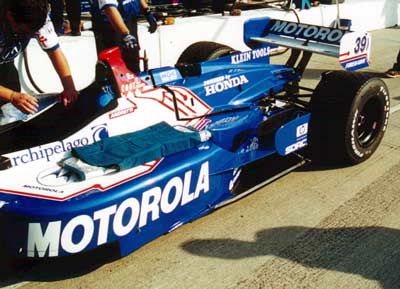
Michael Andretti's Reynard has a fin on the engine cover and an inside endplate on the fugelhorn.
Gary Anderson, new head of Reynard North America fresh from the Jaguar Formula 1 team, was very visible at Long Beach. He's a hands-on guy who will have an influence on the Reynard product.
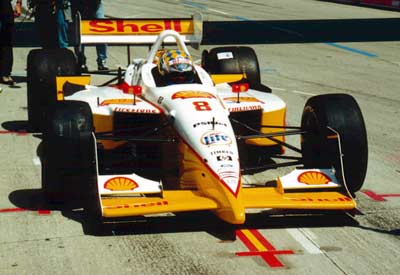
Kenny Brack leaves pit lane in his Lola. In contrast to the Reynards the front wing is flat and the nose is lower.Lola also raised the leading edge of the sidepods enlarging the inlet area leading to the cooling ducting. This allows more airflow so heat exchangers can be smaller. This could remove some weight and provide better cooling for leaner engine operation and better mileage.
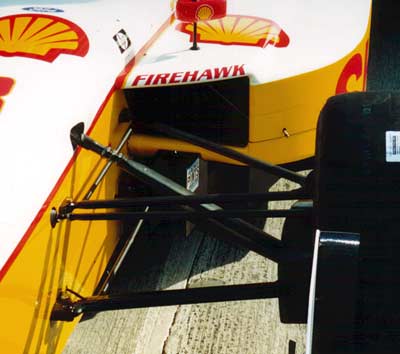

The photo above shows the Lola aero kick-up in front of the rear tire. Lola seems to have an edge on the non-Penske Reynards this year and the Lola aero package is touted to have more downforce with less pitch sensitivity. If that is true it means that, as the nose goes down in the braking zone or comes up due to acceleration, downforce doesn't change much and the center of pressure (CP) of the underwing doesn't move much either. Pitch sensitivity is a function of aero shapes, suspension geometry, and damper tuning. A smoother driver can be an influence also so the whole thing is very subjective. Aero gains are not usually the result of analytical effort but come from time spent in the wind tunnel testing new parts made for a model.

A shot of de Ferran's Penske/Reynard leaving the pit box. Penske aero guys seem to have combined Reynard and Lola shapes in the area just ahead of the rear tires. And that's an important area because you'd like to minimize drag from the tire and maximize airflow to the rear wing and over the diffuser exit.
It looks to me like the engine cover is lower than on the other cars. They're using Honda engines but maybe they've been able to make the hardware more compact to allow better airflow to the rear wing.
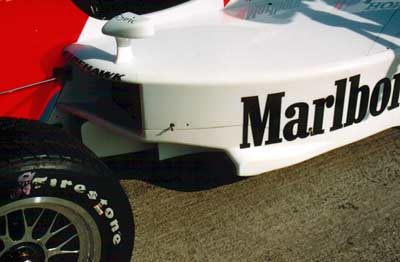
That shoulder on the front, bottom outboard edge of the sidepods has been a Penske aero feature for years. It's gotten smaller and more rounded. This is a required structural hard point required by the rules. The fact that it sticks out from the sidepod might mean the Penske sidepod is narrower in this are than the other cars. The turning vanes in the inlet are easier to see here because they are painted white.